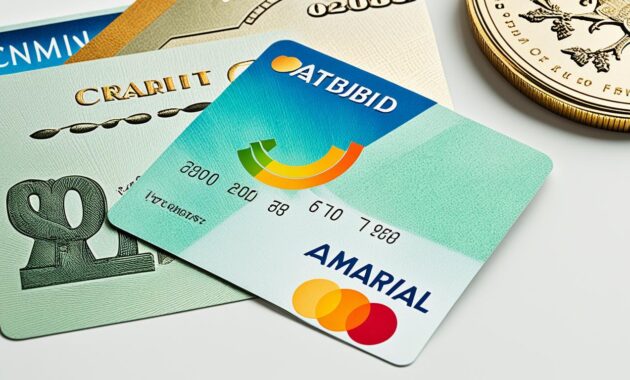Credit cards are an essential financial tool for many individuals, offering convenience, security, and the ability to build credit. However, it’s important to be aware that credit cards often come with annual fees. These fees are charges imposed by credit card issuers in exchange for the benefits and perks provided by the cards.
Annual fees for credit cards can vary widely, ranging from $35 to $500 or even more. The cost of the annual fee depends on the card and the rewards and perks it offers. Some common perks include cash back, travel rewards, and welcome bonuses.
When considering whether to pay an annual fee for a credit card, it’s crucial to evaluate your own spending habits and lifestyle. Consider the value you’ll get from the card’s perks and rewards and whether they outweigh the cost of the annual fee for your specific financial situation.
Key Takeaways:
- Credit cards often charge annual fees as a trade-off for the benefits and perks they provide.
- The cost of the annual fee varies depending on the card and its rewards and perks.
- Consider your spending habits and the value you’ll get from the perks before deciding to pay an annual fee.
- Compare cards with and without annual fees to determine which offers the best value for your needs.
- Make sure to manage your credit card usage responsibly and take advantage of the perks to get the most out of your card.
Why Do Credit Cards Have Annual Fees?
One common aspect of credit cards is the annual fee. But why do credit cards charge this fee? Let’s delve into the reasons behind credit card annual fees and understand their role in the credit card industry.
Credit card companies impose annual fees to help offset the costs associated with providing various rewards and perks to their cardholders. These fees contribute to the profitability of the credit card industry, alongside interest charges and interchange fees. The amount of the annual fee varies depending on the card and the benefits it offers.
Card issuers incur expenses in providing perks such as cashback rewards, travel benefits, and welcome bonuses to their customers. These benefits can enhance the cardholder’s experience and provide added value, but they come at a cost. The card issuer charges an annual fee to cover these expenses and generate revenue.
The cost of the annual fee typically corresponds to the level of benefits and rewards that the credit card offers. Cards with more extensive perks and rewards tend to have higher annual fees. For example, premium travel credit cards that provide access to airport lounges, travel insurance, and concierge services often have higher annual fees than basic no-annual-fee cards.
Card issuers carefully assess the costs and potential revenues associated with a credit card offer. They aim to strike a balance between attracting customers with enticing perks and ensuring the annual fee covers the cost of providing those benefits.
Overall, credit card annual fees enable card issuers to offer attractive rewards and benefits to their customers while maintaining a profitable business model.
The Cost of Annual Fees
It’s important to note that the cost of the annual fee varies among different credit cards. Some cards may charge a modest annual fee, while others may have a higher fee due to the premium benefits they offer.
Here is a table comparing the annual fees of different credit cards:
| Credit Card | Annual Fee |
|---|---|
| Card A | $75 |
| Card B | $150 |
| Card C | $250 |
As seen in the table, the annual fees can range from $75 to $250 or even higher for certain premium cards. The cost of the annual fee should be weighed against the benefits, rewards, and perks offered by the card to determine its overall value.
The decision to pay an annual fee for a credit card ultimately depends on the individual cardholder’s financial situation, spending habits, and the potential benefits they will receive. Assessing the cost of the annual fee and comparing it to the advantages and rewards provided can help cardholders make an informed decision.
How Are Annual Fees Paid?

The payment process for annual fees on credit cards is relatively straightforward. Once a year, typically in the same month that the cardholder signed up for the card, the annual fee is charged as a lump sum on the credit card statement. This fee is shown alongside regular purchases made with the card. Different credit card issuers may have their own specific payment methods and policies when it comes to annual fees.
Cardholders can pay the annual fee using the same methods they use to pay for their regular purchases. This can include online payments through the credit card issuer’s online portal or mobile app, as well as by phone or mail. Some credit card issuers also allow automatic payments, where the annual fee is deducted from the cardholder’s linked bank account on the due date.
It’s important for cardholders to review their credit card statement carefully to ensure they are aware of the annual fee and to make the payment on time. Failure to pay the annual fee can result in late fees, interest charges, or even cancellation of the card.
Cardholders should familiarize themselves with their specific credit card issuer’s payment policies and due dates to ensure timely payment of the annual fee.
When considering the payment of annual fees, it’s also worth noting that some credit cards, such as certain Capital One rewards cards, may offer a statement credit that offsets the annual fee. This means that the cardholder can use their accumulated rewards points or travel credits to reduce the cost of the annual fee. It’s important for cardholders to understand the terms and conditions of their rewards program to take full advantage of these benefits.
Example of a Table:
| Credit Card | Annual Fee | Rewards Program |
|---|---|---|
| Capital One Venture Rewards Credit Card | $95 | Earn unlimited 2x miles on every purchase |
| Chase Sapphire Preferred Card | $95 | Earn 60,000 bonus points after spending $4,000 in the first 3 months |
| American Express Gold Card | $250 | Earn 4x points at restaurants worldwide and 4x points at US supermarkets (up to $25,000 per year) |
Evaluating Annual Fees and Rewards Programs
When deciding whether to pay an annual fee for a credit card, it’s essential for cardholders to evaluate the benefits and rewards program associated with the card. Considerations such as travel rewards, cash back offers, and other perks can play a significant role in determining whether the annual fee is worth it.
For example, credit cards with annual fees may offer valuable travel credits or travel rewards programs. These programs can provide cardholders with benefits such as airport lounge access, travel insurance, and complimentary upgrades. Frequent travelers who can take advantage of these perks may find that the annual fee is justified by the savings and benefits they receive.
Similarly, rewards programs that offer cash back or bonus points for specific spending categories, such as dining or groceries, can help offset the annual fee. Cardholders who frequently make purchases in these categories can earn significant rewards that can make the annual fee worthwhile.
Ultimately, the decision about whether to pay an annual fee for a credit card depends on an individual’s spending habits, lifestyle, and the value they assign to the card’s benefits. It’s important for cardholders to carefully consider these factors and assess whether the rewards and perks offered by the card outweigh the cost of the annual fee.
Is Paying an Annual Fee Worth It?

Whether or not paying an annual fee is worth it depends on the individual cardholder’s financial situation, spending habits, and the benefits they will receive from the card. Some cards offer substantial incentives, such as welcome bonuses or rewards that can offset the annual fee. For example, a card with a $95 annual fee may offer a welcome bonus worth $750 in travel expenses, making the fee worth it for some cardholders. However, not all cardholders may find the benefits outweigh the cost of the annual fee, especially if they do not use the card’s perks.
Pros and Cons of Paying an Annual Fee
Before deciding whether to pay an annual fee for a credit card, it’s essential to weigh the pros and cons. Let’s take a closer look:
| Pros | Cons |
|---|---|
|
|
Consider your own financial goals, spending patterns, and the specific benefits provided by the card in question. It’s essential to calculate the potential value you’ll gain from the perks and rewards, keeping in mind the annual fee you’ll need to pay.
If you’re someone who frequently uses credit cards for everyday purchases and can maximize the rewards and perks offered, paying an annual fee might be worthwhile. On the other hand, if you don’t spend much, travel infrequently, or find that the benefits do not align with your lifestyle, it may be better to opt for a no-annual-fee credit card.
Ultimately, the decision to pay an annual fee for a credit card is a personal one that should be based on careful consideration of your financial situation and the potential value you’ll gain from the card’s perks and rewards.
Factors to Consider When Evaluating an Annual Fee Card
When it comes to choosing a credit card, one important factor to consider is whether or not it charges an annual fee. Many credit card companies offer cards without an annual fee, while others have an annual fee that cardholders must pay. Deciding whether to choose a card with an annual fee or a no-annual-fee credit card requires careful consideration of various factors.
1. Welcome Bonus: One of the key factors to consider when evaluating an annual fee card is the welcome bonus. Some credit cards offer a sign-up bonus or welcome bonus that provides cardholders with a significant amount of rewards points, miles, or cash back when they meet specific spending requirements within a certain time frame. These welcome bonuses can offset the annual fee in the first year and provide immediate value for cardholders.
2. Rewards and perks: Another important consideration is the value of the rewards and perks that the card offers. Does the card provide cash back, travel rewards, or other benefits that align with your spending habits and lifestyle? It’s essential to assess whether the value of the rewards and perks offsets the annual fee. For example, if a card offers high cash back rates or allows you to redeem rewards for travel, the savings or benefits you gain from utilizing the card’s features may outweigh the cost of the annual fee.
3. Comparing with no-annual-fee cards: To evaluate the worthiness of an annual fee card, it’s crucial to compare it to similar cards without an annual fee. Consider the rewards and perks offered by both types of cards and weigh the benefits against the cost. Determine whether the annual fee card provides enough additional value to justify the fee when compared to a no-annual-fee card.
4. Offsetting the annual fee: Some annual fee cards offer benefits that can offset the annual fee over time. For instance, a card might offer an annual travel credit or access to airport lounges that can be valued at an amount equal to or greater than the annual fee itself. If the value of these benefits outweighs the annual fee, the card may be worth considering.
5. Your spending habits: Take a close look at your spending habits and determine if they align with the card’s rewards structure. If a card offers higher rewards for categories that you frequently spend on, such as dining or travel, then the rewards you earn can help offset the annual fee. On the other hand, if the card’s rewards categories don’t match your spending patterns, the annual fee may not be worth it.
6. Redemption options: Consider how easy or difficult it is to redeem the rewards earned with the card. Some cards offer flexible redemption options, allowing you to use your rewards for travel, merchandise, or statement credits. The flexibility of redeeming rewards can increase the value of the card and make the annual fee more worthwhile.
Comparison of Annual Fee and No-Annual-Fee Credit Cards
| Card Features | Annual Fee Card | No-Annual-Fee Card |
|---|---|---|
| Welcome Bonus | Higher chance of a substantial welcome bonus | Potential for a welcome bonus, but usually smaller |
| Rewards and Perks | Often offers higher rewards rates and additional perks | Rewards rates and perks may be lower or limited |
| Redemption Options | More flexible redemption options, including travel, merchandise, and statement credits | Redemption options may be limited or less flexible |
| Offsetting the Annual Fee | Potential for benefits that can offset the annual fee | No direct benefits to offset the annual fee |
| Annual Fee | Various annual fees depending on the card | No annual fee |
As seen in the table above, there are clear distinctions between annual fee and no-annual-fee credit cards. Cardholders must carefully evaluate the factors mentioned above to decide whether an annual fee card is the right choice for their financial needs and goals.
By taking into account the welcome bonus, rewards and perks, comparing with no-annual-fee cards, assessing the card’s offsetting benefits, considering your spending habits, and evaluating redemption options, individuals can make a well-informed decision on whether a credit card with an annual fee is worth the cost.
Managing Credit Card Usage and Perks

Cardholders need to carefully manage their credit card usage to fully take advantage of the perks and benefits offered by cards with annual fees. By understanding the terms and conditions of the card and staying responsible with credit card usage, individuals can make the most of their card’s features.
For people with poor credit, getting a credit card with an annual fee can actually be worth it. Although it may seem counterintuitive to pay a fee when you already have poor credit, the right card can help rebuild your credit score over time. By using the card responsibly and making regular payments, you demonstrate improved financial behavior, which can positively impact your creditworthiness.
It’s important to activate any insurance perks or subscription discounts that come with your card. Many annual fee cards offer benefits such as travel insurance, purchase protection, or access to exclusive events. By taking advantage of these perks, cardholders can maximize the value they receive from their card.
“Using a credit card with an annual fee is not just about paying for the card itself, but also about the added benefits and rewards that can outweigh the cost.”
When considering whether paying an annual fee is worth it, it’s crucial to evaluate the benefits and rewards that the card offers. If the card provides cash back, travel rewards, or other valuable perks that align with your spending habits, the annual fee can be worthwhile. Always weigh the cost of the annual fee against the value you expect to receive from the card.
Additionally, individuals should be mindful of their credit card bill. By paying the bill in full and on time each month, you can avoid costly interest charges and late payment fees. This responsible payment behavior can also help maintain or improve your credit score, further strengthening your financial situation.
Ultimately, managing credit card usage and perks requires careful consideration of your individual financial needs and spending habits. By understanding the benefits offered by cards with annual fees and using your card responsibly, you can make the most of your credit card and reap the rewards it has to offer.
Finding the Right Card for Poor Credit
If you have a poor credit history and are considering a credit card with an annual fee, it’s crucial to research your options and choose a card that aligns with your needs. Look for cards specifically designed for people with bad credit, as these cards may offer lower fees and faster credit score improvement opportunities. Take the time to compare the benefits, interest rates, and fees associated with different cards to ensure you’re making an informed decision.
Evaluating Perks and Lifestyle Compatibility

When choosing a credit card, it’s important to consider whether the perks offered by a particular card align with your lifestyle and spending habits. One of the factors to evaluate is the annual fee, as the higher the annual fee, the more benefits and perks the card may offer.
For example, if a card offers travel perks such as airline miles or hotel discounts, but you don’t travel frequently, the annual fee may not be worth paying. On the other hand, if you’re a frequent traveler and can take advantage of these perks, the fee may be well worth it.
Another aspect to consider is how the rewards earned from the card’s perks can be redeemed. Some cards allow rewards to be redeemed as a statement credit, effectively reducing the annual fee. This can make the fee more manageable and potentially worth paying for the benefits provided.
Calculating the value of the perks and comparing it to the annual fee is an essential step in determining whether the fee is worth paying. Consider how much you spend on categories that earn rewards and whether the rewards earned will offset the cost of the annual fee.
Evaluating Perks: A Cost-Benefit Analysis
Let’s take an example: Card A has an annual fee of $250, but it offers a 5% cash back on dining and 3% cash back on travel. If you spend $2,000 annually on dining and $3,000 on travel, you would earn $100 cash back on dining and $90 cash back on travel, a total of $190. In this case, the rewards earned are greater than the annual fee, making it a fee worth paying.
Cardholders should carefully evaluate the cost-benefit analysis of a credit card’s perks and the annual fee to determine if it’s worth paying. By considering their spending habits and the value they will get back from the card’s perks, they can make an informed decision.”
The average annual fee for credit cards with perks varies depending on the level of benefits provided. Some cards may have lower annual fees, while others may have higher fees due to premium perks and benefits. It’s essential to carefully consider the cost-benefit analysis of each card and whether the perks align with your lifestyle and spending habits.
In the next section, we’ll explore a scenario where the annual fee outweighs the perks and how to make informed decisions about annual fees.
When the Annual Fee Outweighs the Perks

Sometimes, the perks and benefits offered by a credit card may not justify the high annual fee. It’s important for cardholders to carefully evaluate their credit history and the types of credit they have to determine if the perks and benefits offered by the card are worth the cost. While some credit cards may charge high annual fees, they may also offer valuable rewards and incentives that can help offset the cost.
One way that credit cards can help offset high annual fees is by offering a generous travel credit. For example, some premium travel credit cards offer a $300 travel credit that can be applied towards flights, hotels, or other travel expenses. By taking advantage of this credit, cardholders can effectively reduce the net cost of the annual fee.
Additionally, certain credit cards may offer fee waivers that can further mitigate the impact of the annual fee. These fee waivers can be based on factors such as the cardholder’s spending habits, loyalty to the credit card issuer, or other qualifying criteria. By qualifying for a fee waiver, cardholders can avoid paying the annual fee altogether.
When evaluating the affordability of an annual fee, it’s essential to consider the potential rewards and benefits that the credit card offers. Some credit cards are specifically designed to be rewarding, offering cash back, travel rewards, or other perks that can provide significant value. Cardholders should carefully assess whether the ongoing benefits they will receive from the card outweigh the cost of the annual fee.
| Credit Card | Annual Fee | Perks and Benefits |
|---|---|---|
| Card 1 | $150 | 3% cash back on dining and entertainment, $100 sign-up bonus |
| Card 2 | $200 | $300 travel credit, airport lounge access |
| Card 3 | $250 | 5% cash back on groceries, 0% APR for 12 months |
Table: Comparison of credit cards with annual fees and their perks and benefits.
As seen in the table above, credit cards with high annual fees can offer attractive perks and benefits that may make the fee worth paying. However, it’s crucial to carefully consider whether the rewards and benefits align with your spending habits and lifestyle. For example, if you rarely travel, a credit card with a high annual fee that offers generous travel rewards may not be the best fit for you.
In summary, the decision of whether the annual fee is worth it depends on a variety of factors, including your credit history, types of credit, and the perks and benefits offered by the credit card. By evaluating these factors and comparing the value of the rewards and benefits against the cost of the annual fee, you can make an informed decision about whether a credit card with a high annual fee is truly rewarding for you.
Making Informed Decisions About Annual Fees

When considering credit cards with annual fees, it’s crucial for cardholders to make informed decisions based on their unique financial circumstances and needs. By carefully evaluating important factors, such as credit score, card usage, and the benefits offered, individuals can determine whether the cost of an annual fee is justified.
For those with fair credit, the options for credit cards without annual fees may be more limited. In such cases, it becomes necessary to weigh the benefits provided by a card with an annual fee against its cost. By assessing the potential rewards, travel benefits, and premium features that come with these cards, individuals can determine if the annual fee is worth it for their specific situation.
However, it’s crucial not just to focus solely on the annual fee itself. Cardholders should also carefully evaluate other fees associated with the card, such as interest rates and additional charges. This assessment ensures that individuals are getting the most value for their money and can truly maximize all the benefits and travel perks offered by the card.
Benefits such as:
- Premium travel rewards
- Exclusive travel benefits
- Generous welcome bonuses
By considering these factors, individuals can weigh the value of the benefits against the cost of the annual fee, ultimately making an informed decision about whether a particular credit card is worth it for them.
It’s important to note that while an annual fee may not be worth it for everyone, it can be a smart financial move for some individuals. Those with higher spending habits, frequent travelers, or individuals who can fully leverage the bonus offers and travel benefits may find that the annual fee is worth paying.
Just remember:
“The bonus is worth up to $500 in travel expenses.“
In summary, understanding the value of annual fees and evaluating their benefits and costs is essential for making the right decision. By thoroughly assessing personal needs, spending habits, and the potential rewards offered by the card, individuals can determine whether paying an annual fee is worth it for them. It’s important to remember that what’s worth it for some people may not be the case for others. Each individual should carefully consider their unique circumstances and financial goals to make an informed and logical decision.
Also Read : Technology For Credit Card Security
Conclusion
In conclusion, credit cards often come with annual fees that offer perks and benefits to cardholders. However, whether or not paying an annual fee is worth it depends on individual financial circumstances and spending habits. It’s important to carefully evaluate the rewards and perks offered by the card, as well as consider your own lifestyle and usage patterns to decide whether the annual fee is worth paying.
By weighing the benefits against the cost, you can decide whether a card with an annual fee makes sense for your financial situation. Some credit cards charge annual fees but provide significant rewards and perks that can offset the cost. On the other hand, there are credit cards available that do not charge an annual fee, which may be more suitable for those who do not use the card’s perks extensively.
Ultimately, the decision to pay an annual fee for a credit card is a personal one that should be based on careful consideration of the card’s benefits and the individual’s financial circumstances. By understanding your priorities and evaluating the value you’ll get from the card, you can make an informed decision and choose a credit card that aligns with your needs and preferences.
FAQs
Q: What is a credit card with an annual fee?
A: A credit card with an annual fee is a card that requires the cardholder to pay a set amount each year to maintain the account.
Q: Is it worth paying an annual fee for a credit card?
A: Whether it’s worth paying an annual fee for a credit card depends on the benefits offered by the card, such as travel perks, cash-back rewards, or other incentives.
Q: How can I decide whether a card with an annual fee is right for me?
A: You should assess your spending habits, lifestyle, and financial goals to determine if the benefits of the card outweigh the annual fee. Consider factors such as travel rewards, cash-back offers, and other perks.
Q: Do all credit cards charge annual fees?
A: No, not all credit cards charge annual fees. There are plenty of options available without annual fees, including secured credit cards and certain rewards cards.
Q: What are some examples of credit cards that offer travel perks?
A: Some credit cards that offer travel perks include the Chase Sapphire Reserve® which provides a $300 travel credit annually, and the American Express Blue Cash Preferred® card which offers cash back on select travel purchases.
Q: How can I determine if an annual fee is worth paying for a credit card?
A: Consider the benefits of the card, such as cash-back rewards, travel credits, and other perks. Calculate whether the value of these benefits exceeds the cost of the annual fee.
Q: Are there any circumstances where paying an annual fee can be worth it?
A: Yes, if you frequently travel and can take advantage of travel benefits like free checked bags or access to airport lounges, paying an annual fee for a credit card with travel perks may be worthwhile.
Source Links
- https://www.investopedia.com/financial-edge/0711/credit-cards-should-you-ever-pay-an-annual-fee.aspx
- https://www.capitalone.com/learn-grow/money-management/credit-card-annual-fee/
- https://www.cnbc.com/select/questions-to-ask-yourself-before-paying-credit-card-annual-fee/